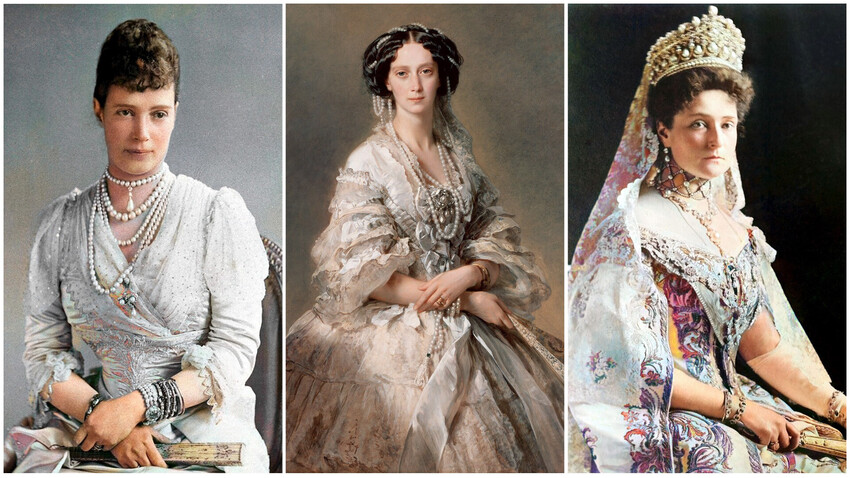
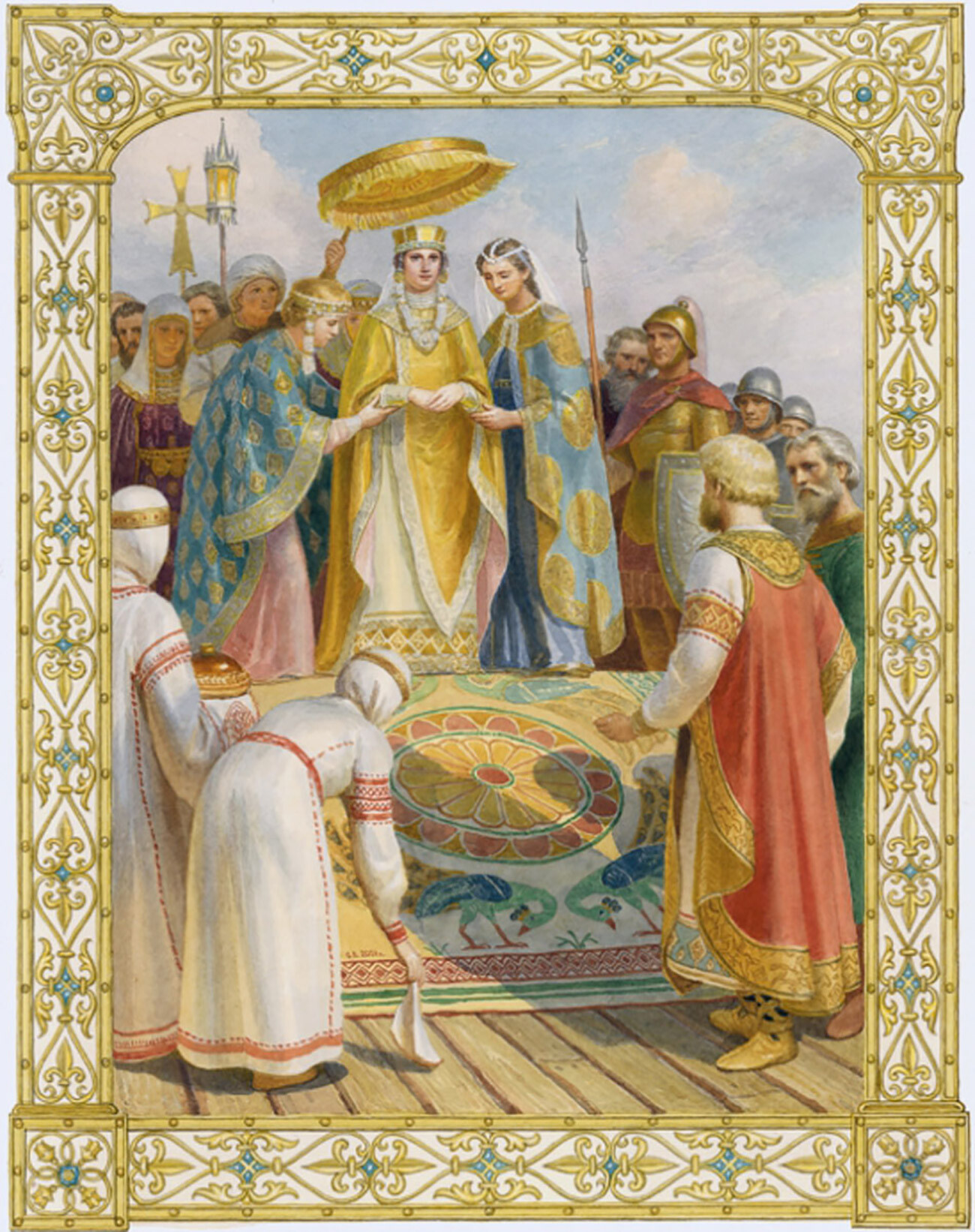
Greek Princess Anna
Sergey EfoshkinBefore the Baptism of Russia, Prince Vladimir most likely ruled a pagan state and professed paganism. There is information that, among his many wives, there were ladies of Czech and Greek origin. When Vladimir captured Korsun (the ancient Greek town Tauric Chersonesos), which belonged to Byzantium, he demanded Tsarevna Anna, the sister of the Byzantine emperor Basil II and his co-ruler Constantine VIII, as his wife.
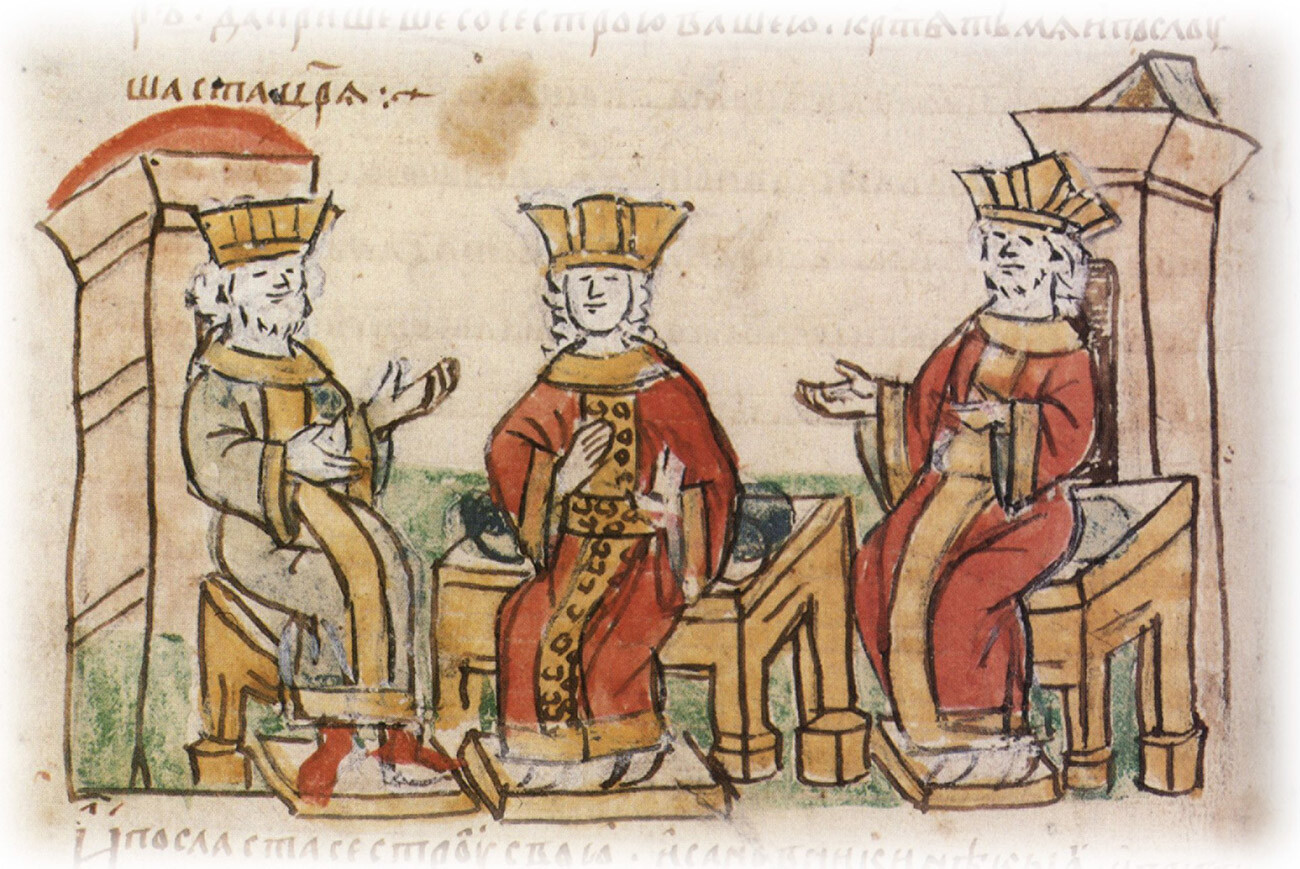
Basil II and Constantine VIII persuading Anna to marry Vladimir of Kiev. An illustration for the Radzivill Chronicle, 15th century
Public domainThe condition on the Byzantine side was the baptism of Vladimir – which meant the spread of Christianity in the lands subject to him. After the baptism, Vladimir and Anna were married according to the Christian rite. Anna actively participated in the Christianization of Russian lands, with many churches built at her expense. She died four years before the death of her husband, in 1011/1012.
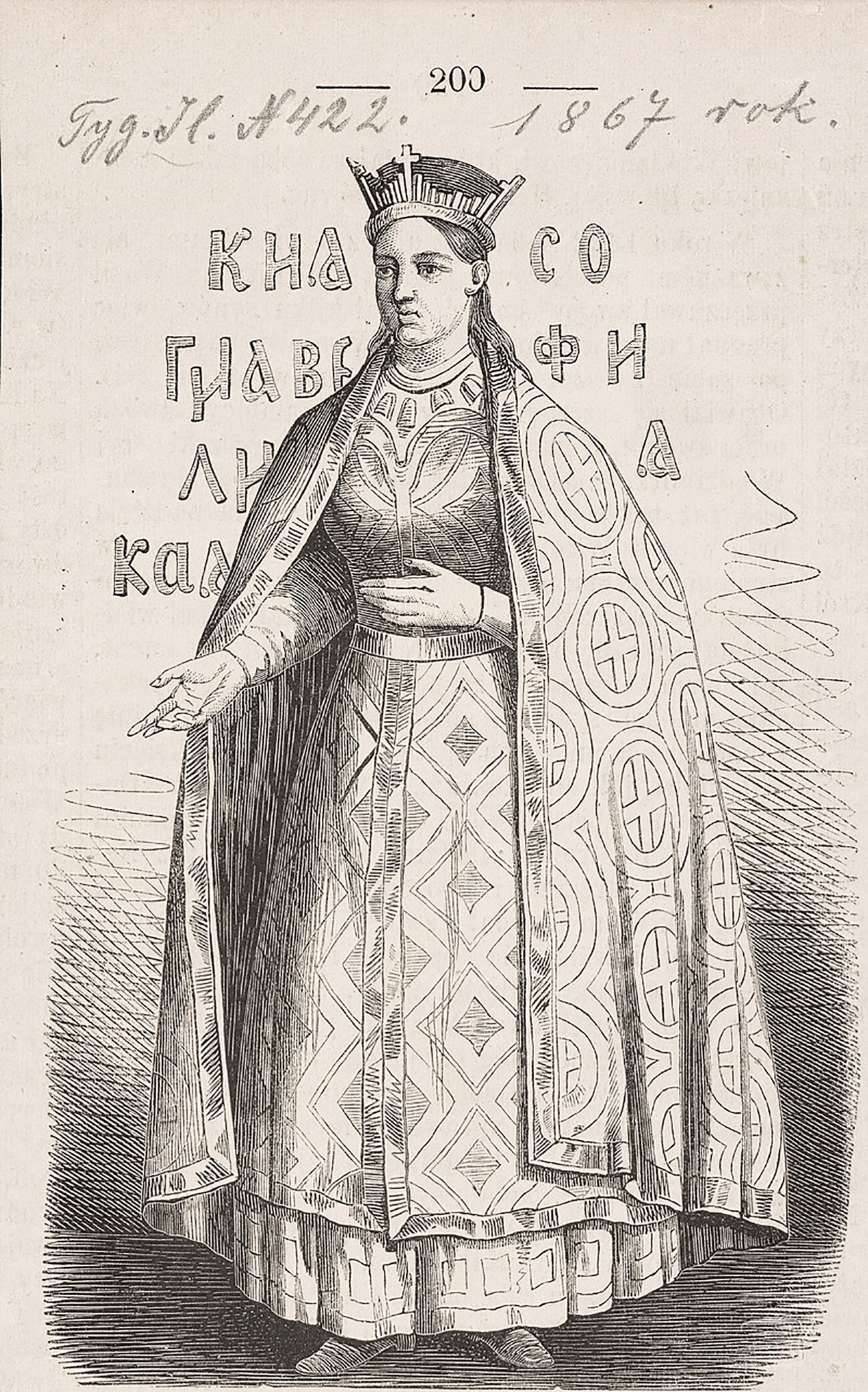
Sofya Vitovtovna
Public domainAt the end of the 14th century, the Moscow Duchy and the Grand Duchy of Lithuania were neighbors – the city of Smolensk then belonged to the Grand Duke of Lithuania, Vytautas the Great. Prince Vasily I of Moscow married Vytautas’s daughter Sophia. They were engaged, according to legend, very young, when Prince Vasily was hiding in Lithuania, having escaped from Tatar captivity.
The wedding took place in 1390 in Moscow. Their marriage ensured peace between Moscow and Lithuania, with four daughters and five sons born in it. After the death of her husband in 1425, Sofia Vitovtovna ruled the Moscow Duchy as a tsarina. She engaged in political life, created drafting laws and, later, in 1451, headed the defense of Moscow from the Tatars. Sophia lived a long life – 82 years, becoming a nun in the Moscow Ascension Monastery at the end of it.

Moscow Grand Princess Sophia Palaiologina (ca. 1455 — April 7, 1503). Forensic facial reconstruction by S. A. Nikitin, 1994.
Sergey Nikitin (CC BY-SA 3.0)Zoe Palaiologina was the niece of Constantine XI, the last Emperor of Byzantium, who died during the capture of Constantinople by the Turks in 1453. After leaving Byzantium, she lived in Rome, where her name became Sophia. In 1469, Pope Paul II proposed to arrange Sophia’s marriage to the Grand Prince of Moscow Ivan III – perhaps in order to bring the Catholic and Orthodox churches closer together. The negotiations lasted three years and, in 1472, Sophia came to Moscow, where she married Ivan III according to the Orthodox rite and to the faith of her ancestors. Sophia did not, however, become a conductor of the influence of Rome in Moscow. She gave birth to nine children and died two years before her husband’s death.
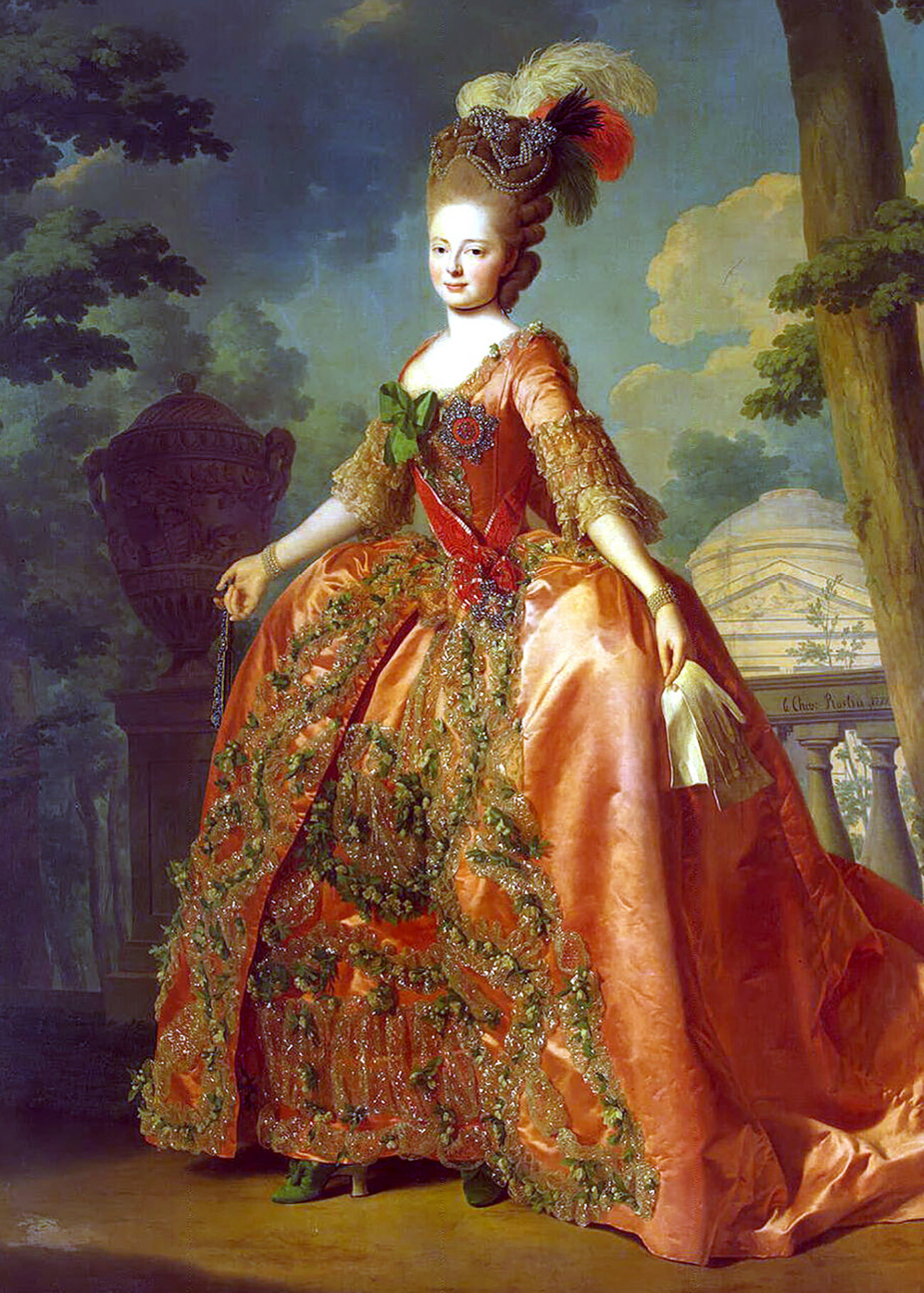
Maria Fedorovna of Russia
Alexander RoslinFor most of the 18th century, Russia was ruled by women – with the exception of the short reign of Peter III in 1762, who was deposed by his wife Catherine II. Their son Pavel Petrovich ascended the Russian throne after Caherine’s death in 1796. His first wife was Princess Wilhelmina Louise of Hesse-Darmstadt (in Orthodoxy, Natalia Alekseevna), who died during childbirth. The second wife was also a European princess, Sophia Dorothea of Württemberg (in Orthodoxy, Maria Feodorovna). A talented artist, sculptor and also an experienced turner, Maria Feodorovna devoted a lot of time to crafts and decoration of the residence in Pavlovsk, where her fascinating works are on display to the present day. After becoming Empress, Maria directed her energy to charity – she was in charge of orphanages, women’s education and the organization of craft schools and colleges, which she continued to do after the death of her husband, during the reign of her sons Alexander I and later Nicholas I. Empress Maria Feodorovna herself passed away in 1828.
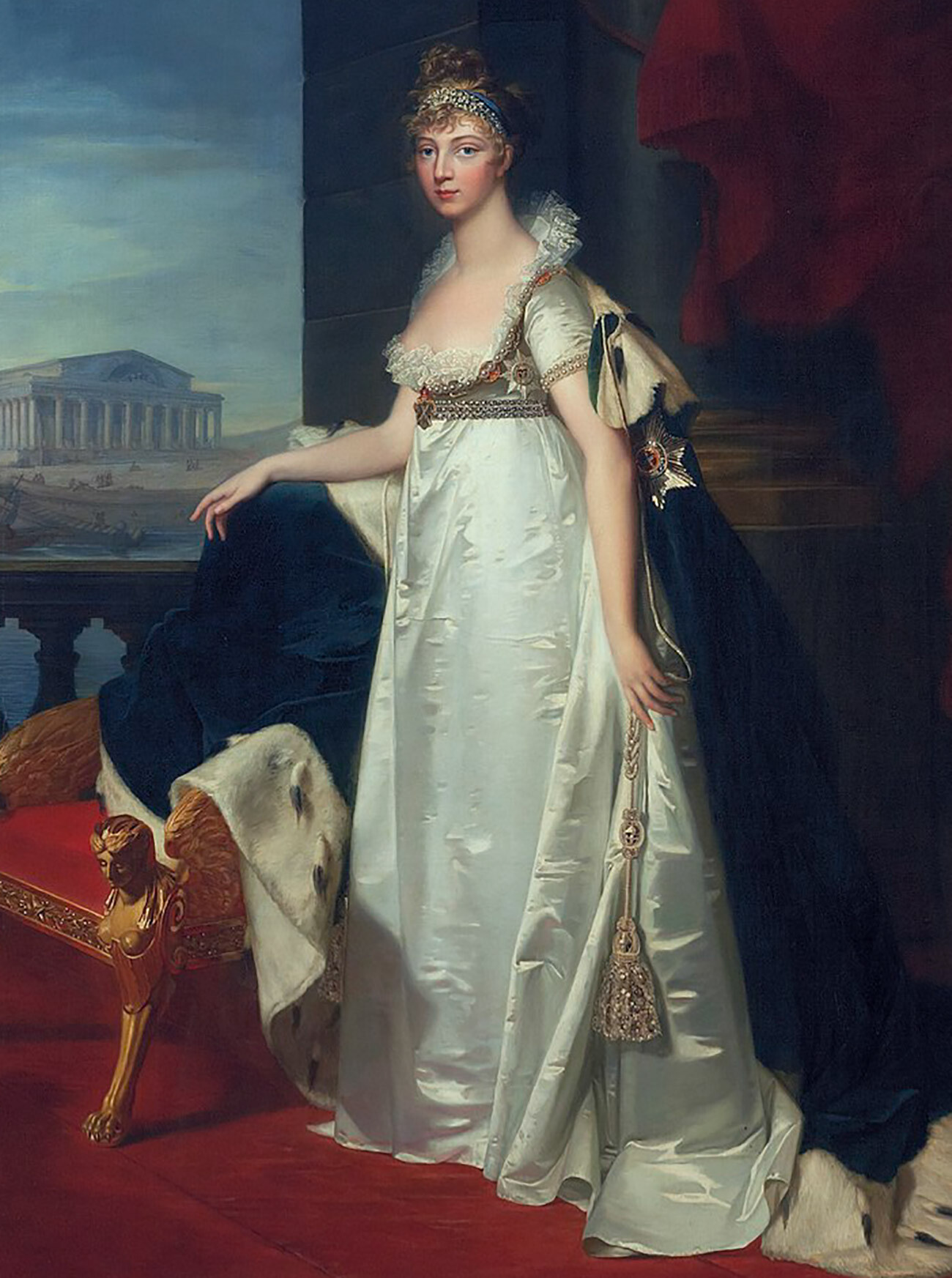
Empress Elizabeth Alexeyevna by Jean-Laurent Mosnier
Jean-Laurent MosnierFollowing Maria Feodorovna, all the wives of subsequent Russian Emperors were European princesses – and many of them were related. Thus, Alexander I’s wife Louise Maria Auguste of Baden (in Orthodoxy, Elizabeth Alekseevna) was the niece of Paul I’s first wife Natalia Alekseevna.
The wife for Catherine II’s grandson was chosen by the Empress herself and the wedding was held during her lifetime, in 1793. The marriage, starting off as an idyllic romance, did not work out in the end – Grand Duke Alexander did not hide his sympathies for the court ladies, while Elizabeth Alekseevna herself was also suspected of infidelity. Both daughters, Maria and Elizabeth, who were born to Elizabeth Alekseevna and died in infancy, were considered children born from extramarital affairs. Elizaveta Alekseevna had no other children. She died in 1826, months after Alexander’s death, but, for a long time after her death, there were rumors that the empress actually went to a monastery, where she lived under a false name.
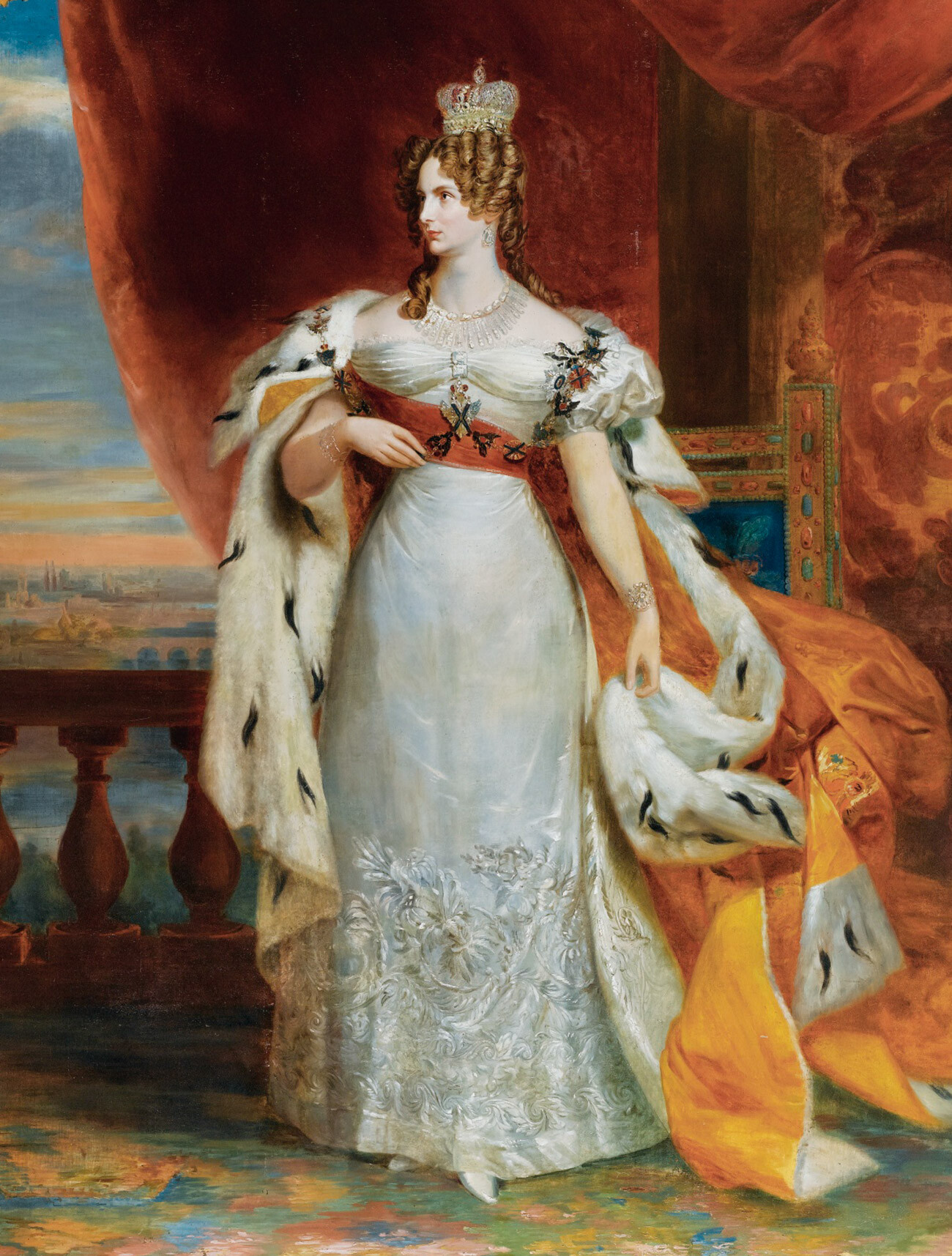
Empress Alexandra Fedorovna by Georges Dawe
Georges DaweFriederike Louise Charlotte Wilhelmina came from the Prussian royal family and met her husband when she was only 15. Their marriage was supposed to strengthen the union of Russia and Prussia. The princess herself hoped for a quiet life away from political intrigues, because Nicholas was not the heir to the Russian throne. They were married in St. Petersburg in 1817 and Friederike Charlotte was baptized into Orthodoxy as Alexandra Feodorovna. After nine months, a son was born, future Emperor Alexander II.
The quiet life of the couple ended in 1825 with the abdication of the heir Constantine Pavlovich – Nicholas became the next emperor and the life of his wife turned into a series of official events, receptions and balls. The tight schedule undermined the already poor health of the Empress, who was constantly ill, due to the harsh northern climate. In addition, by the age of 34, she was already a mother of seven children. After the birth of the seventh child in 1832, doctors did not recommend Alexandra Feodorovna to get pregnant again, which ruined the already unfounded joint life of the spouses. The emperor had well-known favorites and the empress did not have a life of her own. According to the lady-in-waiting Anna Tyutcheva, for Nicholas, “it was a charming bird that he kept locked up in a golden and jeweled cage, which he fed with nectar and ambrosia, lulled with melodies and aromas, but whose wings he would cut off without regret if she wanted to escape”. She outlived her husband by seven years and died in 1860.
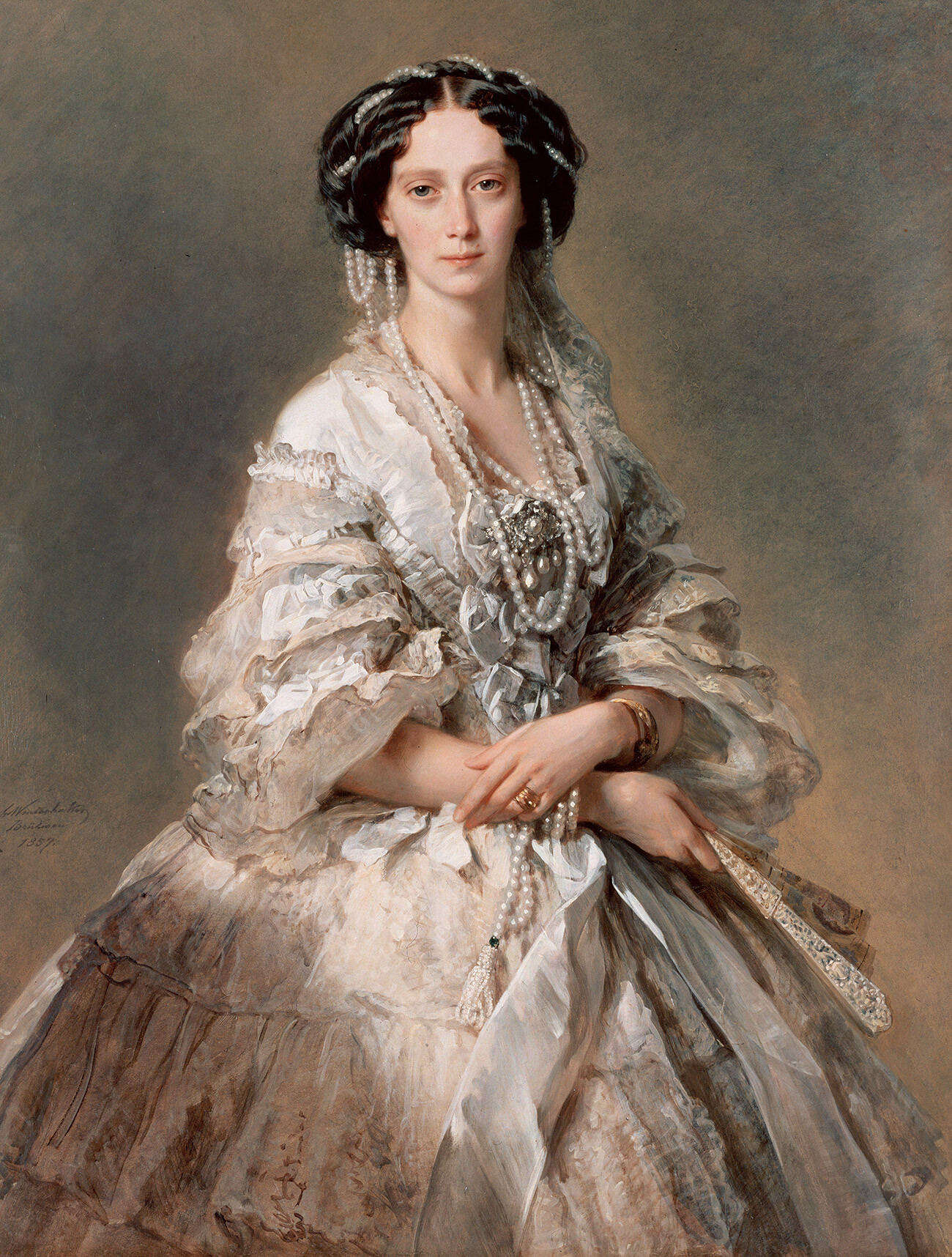
Empress Maria Alexandrovna by Franz Xaver Winterhalter
Franz Xaver WinterhalterGrand Duke Alexander in 1839 was on a voyage through Europe and the heir was wooed by a variety of European princesses. He found them all, according to the memoirs of his sister Olga, “boring and tasteless”. Princess Maria of Hesse (she was 14), on the contrary, did not try to please the heir at all and, thus, captivated him. But, there was a problem with the origin of the girl – she was considered born from her mother’s lover. And, although her father, Ludwig of Hesse, recognized Maria and her brother as his children officially, they lived separately with their mother. To resolve doubts, Alexander’s mother, Empress Alexandra Feodorovna herself went to Darmstadt to get acquainted with her future daughter-in-law and only after that did she agree to the marriage.
In 1840, Maria of Hesse converted to Orthodoxy with the name Maria Alexandrovna and, a year later became the wife of the heir. She was modest and introverted, she participated little in political and social life – even after she became the Russian Empress in 1856, at the age of 30. The queen instead devoted herself to charity. She patronized five hospitals, 12 almshouses, 36 orphanages, two institutes, 38 gymnasiums and 156 schools. With her support, the first branch of the Red Cross was opened in Russia.
The relationship of the spouses cooled over time – the tsar, according to contemporaries, loved a beautiful and free life too much. In 1865, the eldest son and heir Nikolai Alexandrovich died, after which Empress Maria “died internally and only the outer shell lived a mechanical life”, her contemporary Sergey Sheremetev wrote. The latter years of her life were overshadowed by her husband’s romances – the emperor, without any second thoughts, settled his fiance Ekaterina Dolgorukova, with whom he had four children, right in the Winter Palace. Maria Alexandrovna did not survive her husband – she died in June 1880 from tuberculosis. Less than a year after the death of his wife, Alexander II was killed by the terrorists of Narodnaya Volya.
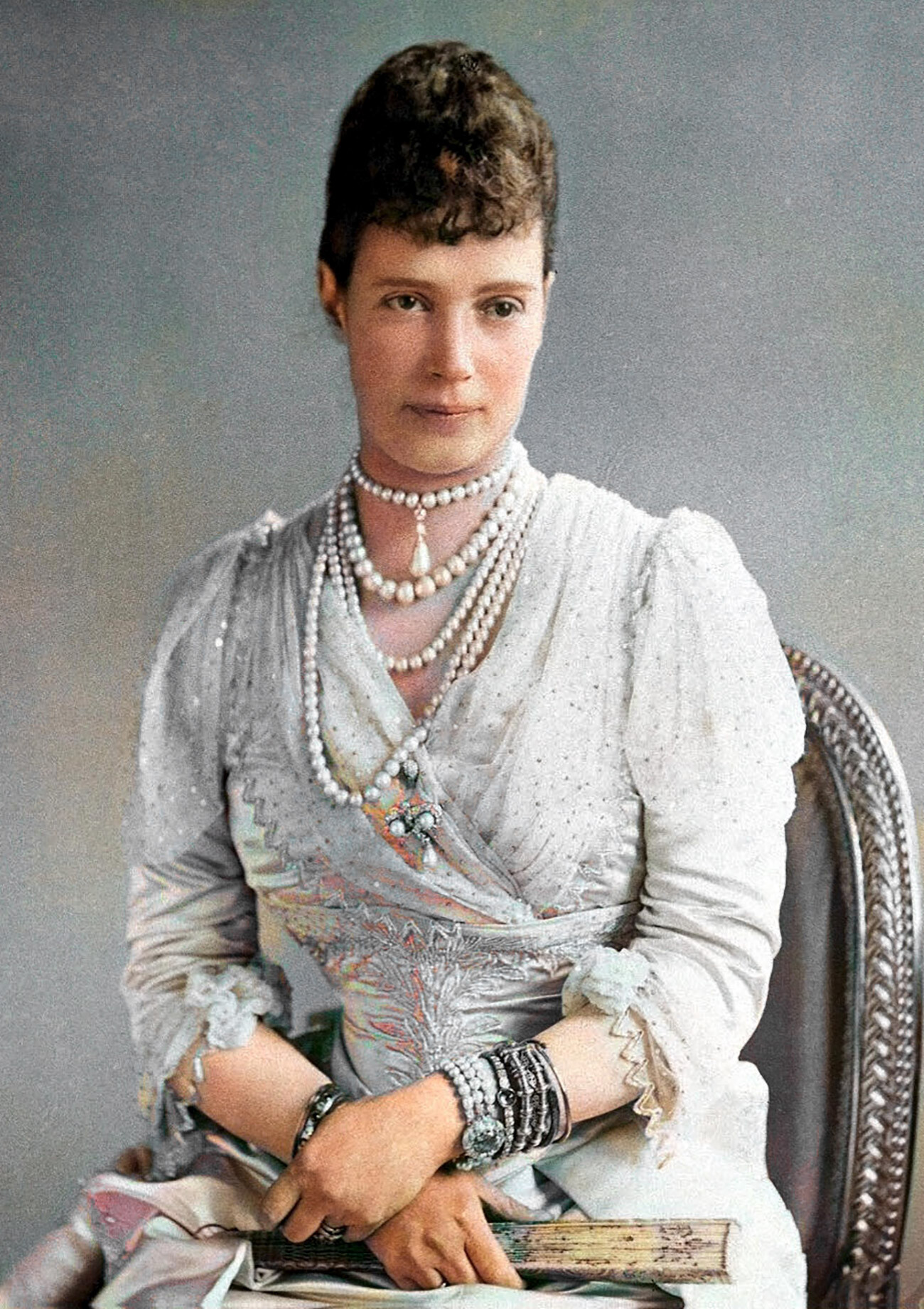
Empress Maria Feodorovna
Sergey LevitskyWhen Nicholas Alexandrovich, the heir to the throne, died in 1865, Grand Prince Alexander took his place, taking with it the bride of the deceased brother, Dagmar of Denmark, as his wife. In Orthodoxy, she became Maria Feodorovna. They were married in 1866.
The marriage, despite the circumstances, was considered happy: the couple had six children. Maria and Alexander shared a passion for art – both had an art education and spent their leisure time painting together. The imperial couple was also fond of collecting – their art collection later formed the basis of the Russian Museum in St. Petersburg. When the family went on vacation to the Finnish skerries or Karelian forests, where the emperor preferred to live “in a simple way” without servants, Maria Feodorovna was happy to lead a “peasant” lifestyle, independently cooking for her husband and family.
By tradition, Maria was engaged in charity work, also heading the Russian Red Cross Society. During World War I, it was she who, as the Dowager Empress, was in charge of organizing hospitals and infirmaries for the wounded at the fronts in St. Petersburg. In 1919, she left Russia. She passed away in Denmark in 1928.
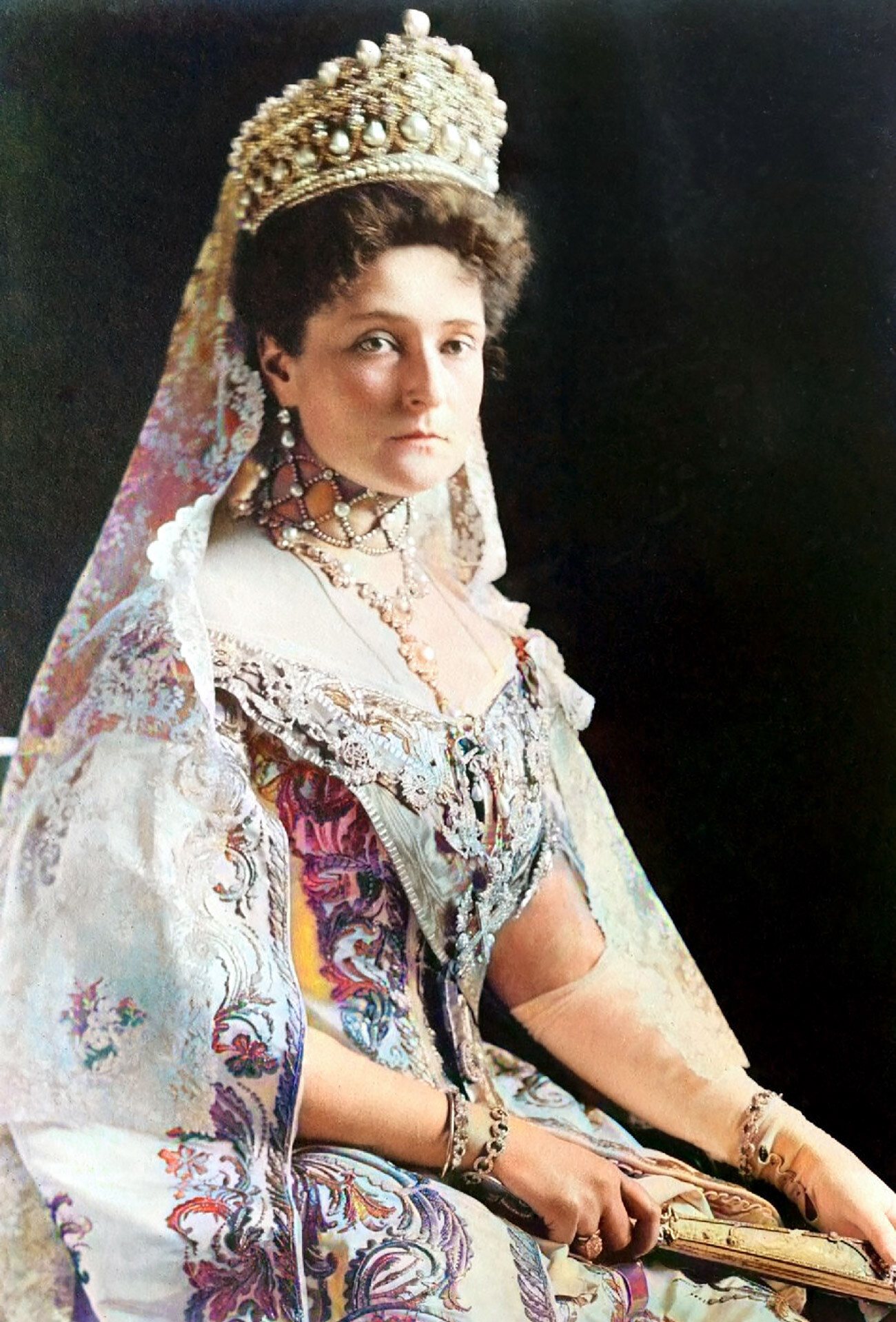
Empress Alexandra Fedorovna
Public domainThe wife of the last emperor was a woman from his family circle. Alix of Hesse was Nicholas’s fourth aunt and second cousin at the same time. Their engagement was opposed by the parents of both Nicholas and Alice – they predicted more profitable parties for their children. But, when Alexander III’s health began to deteriorate, he allowed his son to marry. Alix was baptized into Orthodoxy with the name Alexandra Feodorovna on November 2, 1894, the day after the death of Emperor Alexander III and the wedding with Nicholas took place on November 26 of the same year.
The fundamental issue was the birth of an heir in the family – however, the first four children were girls. In 1904, Tsarevich Alexey was born, who inherited hemophilia from his mother: almost the entire life of the royal family had since been subordinated to the care of the heir. Due to her son’s illness and the general deteriorating situation in the country, Alexandra Feodorovna had frequent nervous seizures. At the height of World War I, she and her daughters were trained in nursing and cared for the wounded in the Tsarskoye Selo Palace, converted into a hospital.
When the Bolsheviks came to power, the royal family was exiled to Tobolsk and then to Yekaterinburg, where, in July 1918, Nicholas II, along with his wife, children and servants, were murdered. Eighty years later, their remains were buried in the Peter and Paul Cathedral in St. Petersburg.
If using any of Russia Beyond's content, partly or in full, always provide an active hyperlink to the original material.
Subscribe
to our newsletter!
Get the week's best stories straight to your inbox